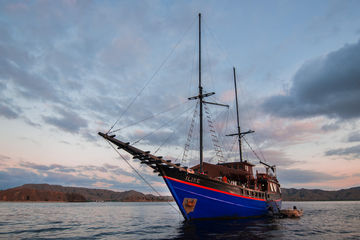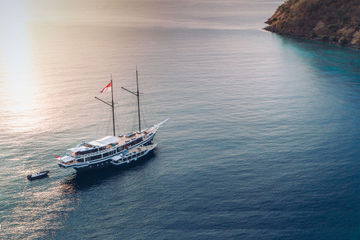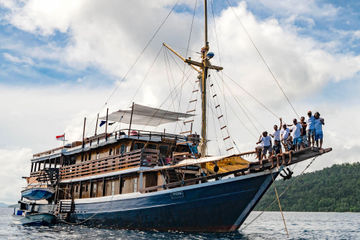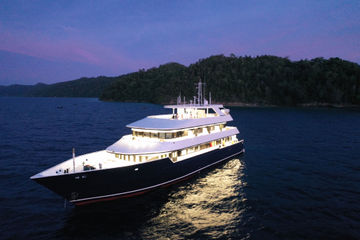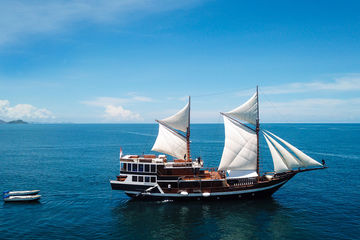Popular Moluccas liveaboards Explore all liveaboards
Liveaboard Diving in Moluccas
What to Expect On a Moluccas Liveaboard
Take a dive liveaboard to the Molucca Islands in Indonesia and step back in time. Unexplored and remote, the Molucca Islands are an archipelago within Indonesia, containing both the Banda and Molucca Seas. Various Indonesian liveaboards offer itineraries to the Molucca region. These islands, also known as the Spice Islands, are situated east of Sulawesi. They span a total area of 850,000 km2, although roughly only 10% consists of landmass. There are very few airports actually within the Moluccas themselves, meaning that the only way to explore truly, or even visit, these islands is by liveaboard. Halmahera and Seram are the two largest islands, while Ternate and Ambon feature a greater infrastructure level. Although in Asia, the fauna here bears more resemblance to the fauna of Australia.
Many islands have been formed by volcanic activity, but tectonic plate collisions have also formed some. When they collide, the ground is thrust upwards to form mountainous peaks, even along a subduction zone (where one plate is forced beneath the other, usually an oceanic plate beneath a far thicker continental plate). Small villages typically occupy most islands visited by liveaboard dive trips or are sometimes entirely uninhabited. The terrain generally falls into two categories, being either mountainous or forested.
In the central and southern regions of the Moluccas, the dry season lasts from October until March, with an average air temperature of 86 Fahrenheit (30∞C). This is usually the wet season period for the rest of Indonesia. Still, seasons in this region are switched, and the wet season is from May until August, with an average air temperature of 73 Fahrenheit (23ºC).
In the northern region of the Moluccas, the seasons resemble those of the rest of Indonesia, with a dry season from April until November. It is best advised for either region to visit during the dry season, although certain areas of the wet season in either region remain relatively dry.
Moluccas Underwater
The Moluccas encapsulate all that is good about Indonesian liveaboard diving. Everything is available, from barrier reefs, atolls, wall and drift dives, muck dives, deep dives, and wreck dives. Better still, the region's inaccessibility means that much of what lies beneath the waves is untouched and unspoiled by human interaction. Aside from the muck diving sites, visibility is generally excellent, over 130 feet (40 m), and even some of the muck sites, particularly around Ambon, feature 65 feet (20 m) visibility on a good day.
The entire region is known as the coral triangle, and for good reason. The exceptionally healthy reefs support some of the highest-ever recorded numbers of both coral and fish species and new species are still being discovered. So much has yet to be explored that many liveaboards even offer the possibility of custom itineraries so that new and incredible dive sites can be discovered.
Dive Sites of Moluccas
Forgotten Islands form a remote chain of islands stretching 1000 km through the Banda Sea from Timor in the southwest to West Papua in the northeast. Waters in this region are some of the clearest in the Moluccas, and the volcanic activity has created fantastic features for divers. There are many swim-throughs, pinnacles, ledges, and overhangs, almost entirely encrusted with various soft and hard corals. Great light conditions help all the colors of the reef to show themselves, especially on Nusa Laut, which houses one of the most spectacular coral gardens.
Halmahera offers a range of liveaboard diving sites, from muck dives to wall dives and drift dives. Much of this region has yet to be explored to any great extent. Still, a recent examination of the reefs showed that Halmahera is home to nearly as many species of fish as Raja Ampat, somewhere in the region of 800 species of fish.
Some of the best muck diving is found around the island of Ambon, particularly the harbor. Just about any species of eel you can think of exists here, including chain morays, black-spotted, and beautifully colored blue ribbon eels. Most diving here can be achieved at shallow depths, and there is no shortage of macro photography opportunities. Brightly colored nudibranchs can be seen feeding upon poisonous corals in order to become poisonous themselves to their predators (a very basic but effective form of defense), and this was the location where the psychedelic frogfish was discovered. Radical man!
Top Tips for Divers
- Many liveaboard dive sites in the Moluccas have yet to be explored to any great extent simply because of their inaccessibility. Conditions can be unknown, especially those regarding possible changes in current strength and direction
- If you ascend somewhere you did not intend, it's a good idea to bring along an SMB and a finger spool to help ensure your location is marked.
- While muck diving, keeping yourself and your equipment properly cleaned following dives is important. These sites are characterized by waste and litter from human activities, especially around Ambon Harbour. For this reason, it is vital to ensure you give your equipment a thoroughly good soak and rinse in clean, fresh water.
- The same applies to ourselves, paying particularly close attention to our ears. A gentle rinse in clean water is usually sufficient to stave off ear infections, while it can be a good idea to carry some form of antibiotic just in case.
Getting to the Moluccas
There are several points of entry to the Moluccas, depending on where you intend to board your dive cruise. Liveaboards sailing in the northern region of the Moluccas will normally depart from either Bitung, on the northern coast of Sulawesi, or from the island of Ternate, located just west of Halmahera.
The best way to reach your Indonesian liveaboard in the northern region is to catch a flight to the international airport at Manado. Many direct flights are available, although long-haul flights will connect from Singapore or sometimes Kuala Lumpur. From Manado, it is a short 1.5-hour trip by car to Bitung. Daily flights from Manado airport are available if your cruise departs from Ternate.
Liveaboards sailing the southern region of the Moluccas tend to set sail from Timor or Flores. The nearest airport is Maumere on the island of Flores, and it can be reached by plane from Bali or Jakarta. Just like Manado, long-haul flights to these airports will normally connect via Singapore or Kuala Lumpur, but sometimes Hong Kong.
Moluccas Diving Reviews
- 9.2 Superb
- 2 Verified Reviews
